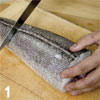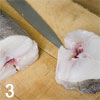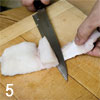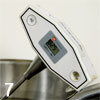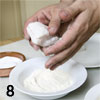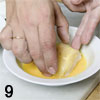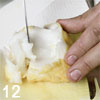Merluza confitada
Modern Spanish cooking attracts the attention of the world. It's imaginative, clever, sexy. What outsiders don't always grasp is that much of the invention links closely with traditional cooking. Basque chefs, for instance, don't sing from the same song sheet as Ferran Adrià at El Bulli. They use their technical know-how to heighten the natural flavours of immaculate produce rather than transform them into something unrecognisable from the original.
Francis Perego's merluza confitada isn't a "confit" in the French sense; that is, a recipe designed for long storage. There's no simple word in the culinary lexicon to describe the process: it's both fast-fried and marinated in warm oil - and in that order. Actually, it brings together a centuries-old recipe and a common cooking method usually reserved for salt cod.
Merluza à la Romana (fried hake) is a dish that every apprentice cook knows how to make. The fish is dipped in flour and egg, then deep-fried in olive oil.
"Templar", or tempering, is a form of gentle poaching in oil that is a favourite Basque way of preparing bacalao.
By choosing a specific cut of fish and filleting it in a way that allows him to form it into a tournedos, chef Perego creates a cut thick enough to sustain the two apparently contradictory techniques.
First he deep-fries the fish, but for a few seconds only, just long enough to set the flour and egg coating. Then he transfers it to an oil bath that lets the temperature through the core of the fish without any drying, but chiefly without leaving the kind of raw core in the centre that would be equivalent to a blue steak.
The result, like meat that's slow-cooked at low temperatures, is a piece of hake that is evenly and lightly cooked all the way through and is uniquely juicy.
Preparation
On taking delivery of the fish, check for freshness. It should smell of iodine and seaweed. Any fishiness makes it inadequate for cooking by this method. Scale it, gut it, clip off the fins with kitchen shears. Cut off the head and shoulder (for soups and stews) and keep chilled at 1°-3°.
The cut
Think of the sides of the fish as being like two fillets of beef, with the châteaubriands being at the head, the tournedos in the middle and the filet mignons at the tail (1). Middle cut lomos (loins) are used for this recipe (2). For two portions, cut a steak weighing 450-500g, bone in (3).
Filleting
With a fish-filleting knife, cut down and along one side of the backbone to expose the fillet. Keeping the edge of the blade against the bones, free the meat (4). Repeat the process with the second fillet.
The thinner flanks of the hake on a very fresh fish are reddish. Damaging the loin as little as possible, and without wasting any of the meat, pare off the discoloured flesh in a single piece, leaving it attached to the skin (5). Lift back this flap and, keeping the blade flat against the meat, peel away the skin. Repeat with the second fillet. Retain the skin and the bones for making the sauce.
Trimming
Fold the thinner flank back over the loin to form a "tournedos". For presentation purposes, trim the fish so as to obtain two perfectly smooth faces. Add any trimmings to the stock.
Yield Portion size, raw weight, is about 140g.
Preparing the oils for frying The hake is going to be cooked in two separate olive oil baths. Their temperatures are critical (6 and 7). The quantities don't matter so long as there is enough to completely cover the fish.
- Bath one 180°-190°
- Bath two 45°-50°.
Flouring and egging Do this to order directly before cooking each portion individually.
Prepare one dish or tray of plain flour and another of lightly beaten egg.
Sprinkle salt over the fish. Coat it in flour on all sides (8). Pick it up and pat the flour down. Do this carefully to obtain the thinnest possible even crust over it.
Transfer to the beaten egg and coat thoroughly (9).
Frying
Lift the fish out of the egg with a fork and spoon. Don't spike it. Touch it as little as possible. Let the excess egg drain from it. Lower it into the first oil bath for about 15 seconds, and no more than 20 seconds. Lift it out of the first bath with the spoon and fork. Let it drain briefly and transfer to the second bath. Leave it to temper (confitar) for seven minutes.
It's ready when little congealed blobs of protein start to form in the bottom of the oil (10). Remove from the bath and drain thoroughly on absorbent paper (11).
If the cooking process has been carried out correctly, the outside will have formed a thin, lightly golden skin and the flakes of hake inside will be white, opaque and juicy (12). They should not seem raw.
Once the fish has been cooked and patted dry it should be served as quickly as possible.
Sauce
Ingredients
(Serves 10-12)
150g hake trimmings
60g peeled potatoes
20g rice (Calespara) (Calasparra?)
50g chopped onion (or 50-50 leek and onion)
30g sliced carrot
Small pinch saffron
Salt
25ml very good extra virgin olive oil
500ml water
Method
Put all the ingredients in a pan and simmer until the rice is soft - about 30 minutes. Remove all the fish bones and as much of the skin as possible. Thermomix or alternatively liquidise to obtain a light emulsion and strain.
Serve the sauce warmed, but not piping hot. It should have the texture of a light emulsion.
Note: In most kitchens it will be easier to make a simple, unflavoured hake stock, strain it and cook the other ingredients in it.
Green pimientos stewed in oil The best green peppers for this are about 15cm long, tapering and grown for flavour. One pepper serves two people.
Heat enough oil to bathe the pepper to 90°C. Cook it for 10 minutes. Drain on absorbent paper and cool. Peel the skin which comes away very easily. Split it open lengthwise from the stalk to the tip.
With the tip of a sharp knife cut round the top and remove the seeds in a single piece, to leave the pepper in two halves.
To assemble the dish, fold the halved pepper in the centre of the plate. Lay the hake on it. Spoon two tablespoons of sauce around the fish.
Sprinkle a little Maldon salt on top.
Spanish hake
The best way of illustrating the difference between the hake sought after by top Spanish restaurants and what is commonly available in the UK is by starting with the bottom line. Perego pays €30 per kg for his fish, whereas current Billingsgate prices fluctuate around €5.
The Spanish hake he's interested in - caught in the Bay of Biscay off the North-west Spanish coast, Galicia and the Basque country - is large, ideally line-caught, and very fresh. It has to weigh more than 2kg or it won't be big enough to produce fillets that are thick enough for him.
Hake, a member of the cod family, is a voracious carnivore. It can grow to more than a metre long. By the time it reaches this size, the flaky flesh is firm and well flavoured, much more so than with younger fish.
Caught by inshore fishermen, the species is in short supply, hence the spiralling value. Nor is it a fish with a long shelf life. Kept on dry ice, it will last several days, but the gastronomic restaurants rely on three or more deliveries a week.
Alternatives: hake is a member of the cod family. Cod, haddock and ling, very fresh and weighing 2-3kg, could prove suitable for this preparation. Large-fished - as opposed to farmed - bass might also work.
Photos by Adrian Franklin



